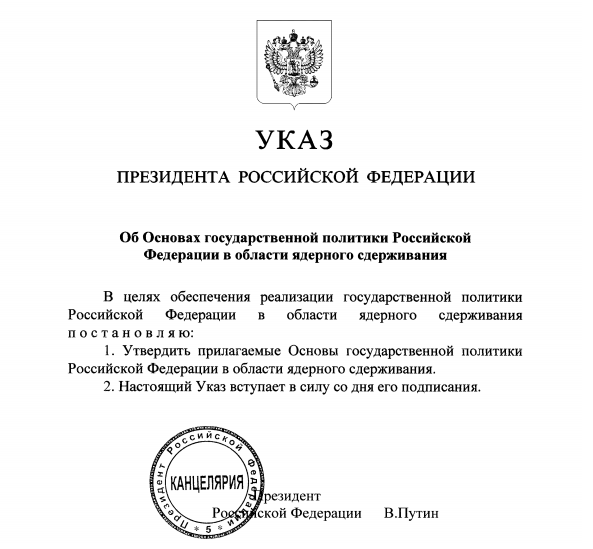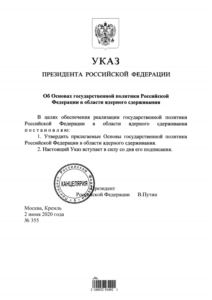
Dr. Nikolai Sokov
Senior Fellow
Vienna Center for Disarmament and Non-Proliferation

On 2 June 2020, Russian President Vladimir Putin signed a decree “Foundations of State Policy of the Russian Federation in the Area of Nuclear Deterrence.” The new document does not introduce much new into the existing nuclear policy as contained in the 2014 Military Doctrine or its previous, 2000 and 2010 versions. Instead, it clarifies many points, which previously remained moot or vague, and details a number of provisions. Overall, it can be said that Russian nuclear policy has demonstrated remarkable consistency during the past two decades: the conceptual foundations have remained the same and its evolution has been limited, and only in response to new external developments as well as upgrades in Russia’s military capabilities.
Russian nuclear deterrence strategy rests on classic foundations dating back to Paul Nitze and Thomas Schelling. If any elements may appear insufficiently clear, sources to resolve these are readily available: one does not have to look beyond Schelling. That framework has dominated Russian thinking about deterrence (including, but not limited to nuclear) since the 1990s and little if anything has changed in the conceptual foundations since then.
That said, the decree is welcome: many important points in Russian policy needed clarification. The debate in the West, especially in the United States, about the conditions under which Russia might use its nuclear weapons and, more generally, the foundations of Russian deterrence policy, has been raging for a long time and especially for the last three years. At the heart of that debate was the question whether Russia had an “escalate-to-deescalate” policy, i.e. limited nuclear use in the midst of a conventional conflict. Some said it did not; other said it did. A specific (and far-fetched) interpretation of the Russian doctrine served as a justification for the deployment of the W76-2 low-yield warhead on American submarine-launched ballistic missiles, which were intended to provide the United States with an option of limited nuclear use in response to Russian limited nuclear use.
There is little doubt that the new decree was intended as a response to the debates in the West, an attempt to put an end to interpretations of Russian policy, which Moscow considers malicious misinterpretations. Obviously, this document will not be able to define that debate, much less end it, but it will have an impact if only because there will be fewer points to interpret or misinterpret.
Greater clarity also helps strengthen deterrence. Classic deterrence theory going back to Thomas Schelling posits that a clear statement about conditions under which military power may be used helps enhance deterrence. Vagueness, on the other hand, risks provoking the opponent, who may mistakenly believe that certain courses of action will not elicit a forceful response. It is far from obvious this was a conscious or at least a major purpose of the decree, but the consequence can hardly be doubted.
The decree clearly defines nuclear deterrence as a defensive policy (the document in its entirety, but especially paragraph 5). Nuclear use is exclusively reserved for situations when Russia is attacked. The document does not differentiate between different levels of military conflict, as did the 2014 Military Doctrine and its predecessors. However, it does allow for nuclear response not only to a large-scale nuclear attack (the “global conflict” scenario, using the terminology of the 2014 and earlier Doctrines), but also to a situation when Russia’s conventional forces are insufficient to repel the attack or are overwhelmed (the “regional conflict” scenario). It would have been desirable to more clearly coordinate the new guidance with earlier documents, but regardless there are no grounds for confusion.
The decree seeks to put an end to conjecture about “offensive deterrence”—a contingency when Russia would launch an aggression and use the threat of “going nuclear” to prevent the United States and NATO from using all available means to repel it. The most popular scenario is Russian occupation of the Baltic States—a contingency that served as a justification for W76-2 warhead and other programmes, such as development and deployment (likely in Europe, in addition to Asia, of intermediate-range, dual-capable, ground-launched missiles). Leaving aside the question why Russia would need the Baltic States, the decree makes clear that nuclear weapons are reserved exclusively for a scenario when Russia is attacked.
Paragraph 9 clearly defines the nature of Russian deterrence policy—it is about deterrence by punishment rather than deterrence by denial. Russia does not promise that the opponent will not be able to achieve its goal; it promises damage to the aggressor that will exceed expected benefits. The decree states in no uncertain terms that effectiveness of deterrence rests on the credibility of Russian deterrence capability.
In line with the 2014 Military Doctrine, the decree talks about two categories of deterrence: nuclear and non-nuclear. It is worth recalling that the notion of non-nuclear deterrence was introduced in 2014 in an indirect reference to the acquisition of modern (long-range, precision-guided) conventional weapons, which were demonstrated in action in the fall of 2015. Until then, relevant missions were almost exclusively assigned to nuclear weapons. The bulk of the document, however, is devoted to nuclear deterrence—a clear reference to the primary interest in the West.
Nonetheless, the decree, which introduces greater clarity, does not clarify all relevant questions and introduces a host of new uncertainties.
The decree promises infliction of “unacceptable damage” in response to an attack (paragraph 10) whereas the 2014 and earlier versions of the Military Doctrine talked about “commensurate” or “tailored” damage. The reasons for the different language are not readily apparent. The classic deterrence theory did, indeed, primarily operate with the notion of “unacceptable” damage, a notion borrowed from former Secretary of Defense (and one of the theorists who defined the notion of nuclear deterrence) Robert MacNamara, who defined it as destruction of 20-25 per cent of population and one-half to two-thirds of industrial capacity. The 2000, 2010, and 2014 Military Doctrines talked, instead, about "damage, subjectively unacceptable to the enemy, which exceeds the benefits the aggressor expects to gain as a result of the use of military force." This definition assumed a variable level of damage depending on the scale of conflict—from “unacceptable” in world war to limited in more limited conflicts.
The reasons for using a less flexible definition are unclear, but the change is significant. Where previous documents talked about tailoring damage to the severity of the threat (attack), the new document seems to promise massive damage in response to any provocation—a statement that is hardly credible. American theorists struggled with that dilemma in the 1950s, realizing that “massive retaliation” was not a “one-size-fits-all” response to every contingency. It is puzzling why Russia, which introduced the notion of tailored deterrence in the 2000 Military Doctrine (years before the United States, which did it in the 2006 Quadrennial Defense Review), suddenly decided to fall back to a clearly outdated notion.
The term “sovereignty” is equally vague. Does it mean that Russia will remain a sovereign State as defined by international law? Or does this notion include survival of the regime? This is perhaps not an issue a Russian official document can be expected to clarify, but it is a matter to contemplate.
Another major uncertainty relates to the height of the nuclear threshold. Following the 2010 and the 2014 Military Doctrines, the decree posits that nuclear weapons would be used in response to an aggression “which puts the very existence of the Russian Federation under threat” (paragraph 17). Paragraph 4, however, talks about “sovereignty and territorial integrity” of the Russian Federation, which is closer to the language that was contained in the 2000 Military Doctrine and allowed for nuclear use “in situations critical for the national security of the Russian Federation and its allies.”
The 2000 language clearly implied the application of the “Kosovo scenario” to the second war in Chechnya. Today, it is also easy to imagine a situation when the “existence” of Russia would not be threatened, but its “territorial integrity” would—for example, an attempt to use force to return Crimea to Ukraine. The change of language may be explainable, but the presence of two very different definitions of nuclear threshold is not.
The scenario that Russian political leadership and military planners have in mind is abundantly clear—a (primarily) conventional attack on Russia. This conclusion directly follows from paragraph 17 and from the list of development that Russia considers dangerous and worth deterring (paragraph 12). These fall into three categories:
An important addition is US and NATO nuclear assets, which did not figure as prominently in the 2000, 2010, or 2014 Military Doctrines. Paragraph 12, subparagraphs “g” and “e,” appear to refer to possible changes in NATO nuclear posture. The Russian military has long considered the US’ B-61 bombs in Europe as a potential threat (even though these are hardly credible from current locations). The prospect that these bombs may be moved to Poland, which became more real after the tweet by US Ambassador to Poland Georgette Mossbacher, would make them more usable, but at the same time significantly increase the level of stand-off in Europe. The same applies to the prospect—perhaps not very probable in real life, but very real in the mind of Russian military planners—of deployment of long-range strike weapons previously banned by the Intermediate-Range Nuclear Forces (INF) Treaty in Europe.
The decree makes it abundantly clear (paragraph 13) that nuclear deterrence applies to all States that have nuclear weapons, as well as their allies. This obviously means all of NATO. As an aside, it is worth noting a fact which is obvious, but that has largely remained moot since the initial debate about NATO enlargement in the early 1990s: States that join NATO to ensure their security vis-à-vis Russia also become legitimate nuclear targets. The provision about the legitimacy of nuclear use against all allies of nuclear States (rather than only those that had US nuclear weapons in their territories) was first adopted in the 1993 “Main Provisions of the Military Doctrine of the Russian Federation.” Of course, that provision does not equally apply to all members of the Alliance (some are more attractive as nuclear targets than others), it is worth keeping in mind that security of each individual NATO member is in direct relationship to the number of “nuclear-worthy” targets per 100,000 square kilometres in its territory. During the Cold War, the obvious leader was West Germany; today other countries compete for that dubious honour.
The decree also lists conditions when nuclear weapons will (almost) definitely be used (Paragraph 18).
The first among them is credible warning about the launch of ballistic missiles against the territory of Russia or its allies (subparagraph “a”). Besides the reference to the launch-on-warning mode of nuclear use (which is only to be expected), this provision raises more questions than it answers.
The second is nuclear strike against the territory of Russia or its allies (subparagraph “b”). This is pretty straightforward, although it remains unclear how this provision is related to the previous one: does it imply the “second strike” posture? Second strike refers to the scenario when a country rides out the nuclear strike of the opponent and responds with what survives. The previous subparagraph clearly states the opposite, and regardless the Russian nuclear arsenal is not sufficiently survivable for the second-strike option.
The third is a conventional strike on nuclear forces and command and control systems. This is a clear reference to the scenario popular in Russia, in which American precision-guided conventional weapons may destroy launchers of Russian strategic missiles (both silo-based and mobile) as well as its command and control centres. This scenario has always been far-fetched and its inclusion into this document appears questionable.
Finally, a conventional attack against Russia, which “threatens the very existence of the State.” The last point brings back the theme that dominates the decree: a conventional attack at a scale that exceeds the capability of Russian conventional forces will be met with a nuclear response. The contradiction between this provision and the more narrow criterion of “sovereignty and territorial integrity” was discussed above.
Which, in turn, brings us to the central question about the Russian military doctrine: does Russia have a “de-escalation” strategy? On the surface, the answer is a resounding “yes.” The entire purpose of nuclear deterrence as defined in Paragraph 4 is to “prevent escalation of a conflict and its termination on conditions acceptable to Russia and/or its allies.” Which means, in plain language, that if Russia faces a major defeat, it will resort to nuclear weapons so that the attacker ends the aggression and returns to status quo ante or perhaps somewhat better for Russia (considering possible compensation for the aggression). If this is not a clear-cut definition of de-escalation, then what is?
However, the situation is not that simple. The decree emphasises deterrence rather than de-escalation. The calculation seems to be as follows: if the opponent knows beforehand that its superior conventional capability, instead of guaranteeing victory, will trigger nuclear use and thus defy the very reason for the attack, then the opponent will refrain from the use of force in the first place. In other words, de-escalation (to the extent the term is applicable) is not a war-fighting strategy, but rather a tool of deterrence. It is not meant to fight war, it is meant to prevent war.
Russian nuclear strategy today is conceptually the same as NATO nuclear strategy during the Cold War, when NATO believed it had to rely on nuclear weapons to balance the perceived Soviet conventional superiority. The most likely scenario is different (striking with precision-guided conventional weapons instead of thousands of tanks). The weapons may be different, but the fundamentals of deterrence remain the same. Those who see offensive qualities in Russian nuclear strategy today, by default condemn NATO Cold War strategy because these two proceed from the same premise.
One major uncertainty about Russian nuclear deterrence policy is its applicability to China. The decree is clearly intended as a message to NATO. On the other hand, China fits all relevant definitions. It possesses nuclear weapons and its conventional capability is vastly superior to that of Russia, so on the surface the same provisions may apply. The answer to that riddle may be contained in paragraph 17, according to which nuclear deterrence applies to States “which view the Russian Federation as a potential adversary.” The “strategic partnership” between Russia and China seems to exclude the latter from the list of states to which the decree applies. Or perhaps it also serves as a not-so-subtle warning that if China decided to change its policy vis-à-vis Russia, then it would join NATO as a legitimate target of nuclear deterrence.
The decree signed by Putin on 2 June 2020 is a positive development because greater clarity about Russian nuclear policy is always welcome. Yet, it also features major uncertainties (some of which may be warranted because they may strengthen deterrence, but others are not) as well as serious contradictions. It is a step in the right direction—as long as this is not the last step and the Russian government continues to elaborate on its nuclear strategy. The document will not end the debate in the West about Russian nuclear policy. It will not affect those who refuse to listen to rational arguments. Nonetheless, it will have a positive impact.

